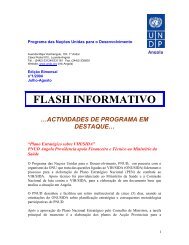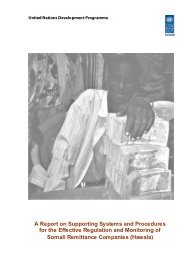CORRUPTION AND ANTI-CORRUPTION STRATEGIES ... - UNDP
CORRUPTION AND ANTI-CORRUPTION STRATEGIES ... - UNDP
CORRUPTION AND ANTI-CORRUPTION STRATEGIES ... - UNDP
You also want an ePaper? Increase the reach of your titles
YUMPU automatically turns print PDFs into web optimized ePapers that Google loves.
and senior officeholder levels. Such initiatives,<br />
however, must first determine how to balance<br />
working through existing institutions with<br />
participatory groups or movements; second,<br />
such initiatives must be aware that government<br />
efforts at promoting economic development or<br />
structural administrative reform may themselves<br />
introduce new actors and patterns of corruption<br />
as development diminishes or renders obsolete<br />
existing corruption; third, they must take<br />
account of traditional, cultural and social<br />
attitudes, ensuring that reforms are seen as<br />
desirable, acceptable and practicable.<br />
Thus, in seeking goals of political and economic<br />
development either voluntarily or under pressure<br />
from external agencies, governments must assess<br />
the most appropriate means to initiate, implement<br />
and sustain reform as well as provide a focus for<br />
co-ordinating and monitoring change.<br />
Consideration must be given, therefore, to the<br />
degree that procedural or structural reforms<br />
may be introduced to limit the opportunities<br />
and incentives for corruption and to raise the<br />
risk of detection, while providing for citizen<br />
involvement, complaints and redress and while<br />
evaluating the appropriate means in terms of<br />
cost, impact, effectiveness and sustainability as<br />
well as the relative political and financial<br />
strengths of those involved in the corruption.<br />
These tasks may often be effectively carried out<br />
by an anti-corruption agency, and could be<br />
important in underpinning and sustaining the<br />
increasing attention which has been given to<br />
another generic response – citizen-level<br />
initiatives as part of moves toward participatory<br />
development, empowering those most adversely<br />
affected by state corruption and most alienated<br />
from the purpose of reform. The measures may<br />
include: legislative sunlight and sunset provisions;<br />
simplified administrative procedures and<br />
oversight controls (one-stop shops and the<br />
customerisation of public services, benchmarking<br />
and service delivery surveys); quick and effective<br />
complaints and redress (hotlines, whistleblowing,<br />
Ombudsmen and administrative tribunals);<br />
community involvement (awareness and education,<br />
transparency of and access to information,<br />
citizens' watchdog groups); and ensuring the<br />
independence of the media. Many of these<br />
institutional reforms are associated with the<br />
ideas of “New Public Management” in western<br />
societies and as such are subject to various<br />
criticisms (Hill, 1997).<br />
Citizen-level initiatives also have three further<br />
roles in terms of governance. First, they are<br />
intended to focus on the poorest members of<br />
society by controlling or minimising smallscale<br />
corruption through protection against the<br />
extractive and arbitrary nature of the state and<br />
its officials, particularly in relations between<br />
the public and the state, including structural<br />
reform (the effects of decentralisation and<br />
deregulation). Second, they encourage improvements<br />
in basic administrative activity by focusing<br />
on the citizen as consumer and customer while<br />
providing easy-to-assess performance measurement<br />
and placing in the public domain the information,<br />
the control over process and the right of redress;<br />
the previous absence of these elements has<br />
prompted the existence and persistence of lowlevel<br />
corruption. Third, they involve the public<br />
in a more direct way than that of party political<br />
participation, at a more local level and with<br />
more immediate benefit to themselves and<br />
their communities.<br />
More integrated schemes involving a number of<br />
initiatives, including anti-corruption campaigns<br />
and the roles of anti-corruption agencies, have<br />
been developed within the context of what is<br />
termed National Integrity Systems where, it<br />
is argued, “leaders in the campaign against<br />
corruption can only achieve real gains when a<br />
society collectively changes its expectation of<br />
public behaviour, or when the people believe<br />
that they are entitled to expect a government<br />
that is not corrupt” and which is worked<br />
toward “in partnership with the government<br />
and the civil society” through awareness-raising<br />
among the civil society, institution building,<br />
prevention of corrupt practices and prosecution<br />
of corrupt officials and where the political and<br />
public wills are underpinned by the appropriate<br />
organisational and procedural integration<br />
(Langseth et al, 1997).<br />
<strong>CORRUPTION</strong>& INTEGRITY IMPROVEMENT INITIATIVES IN DEVELOPING COUNTRIES<br />
5 9







